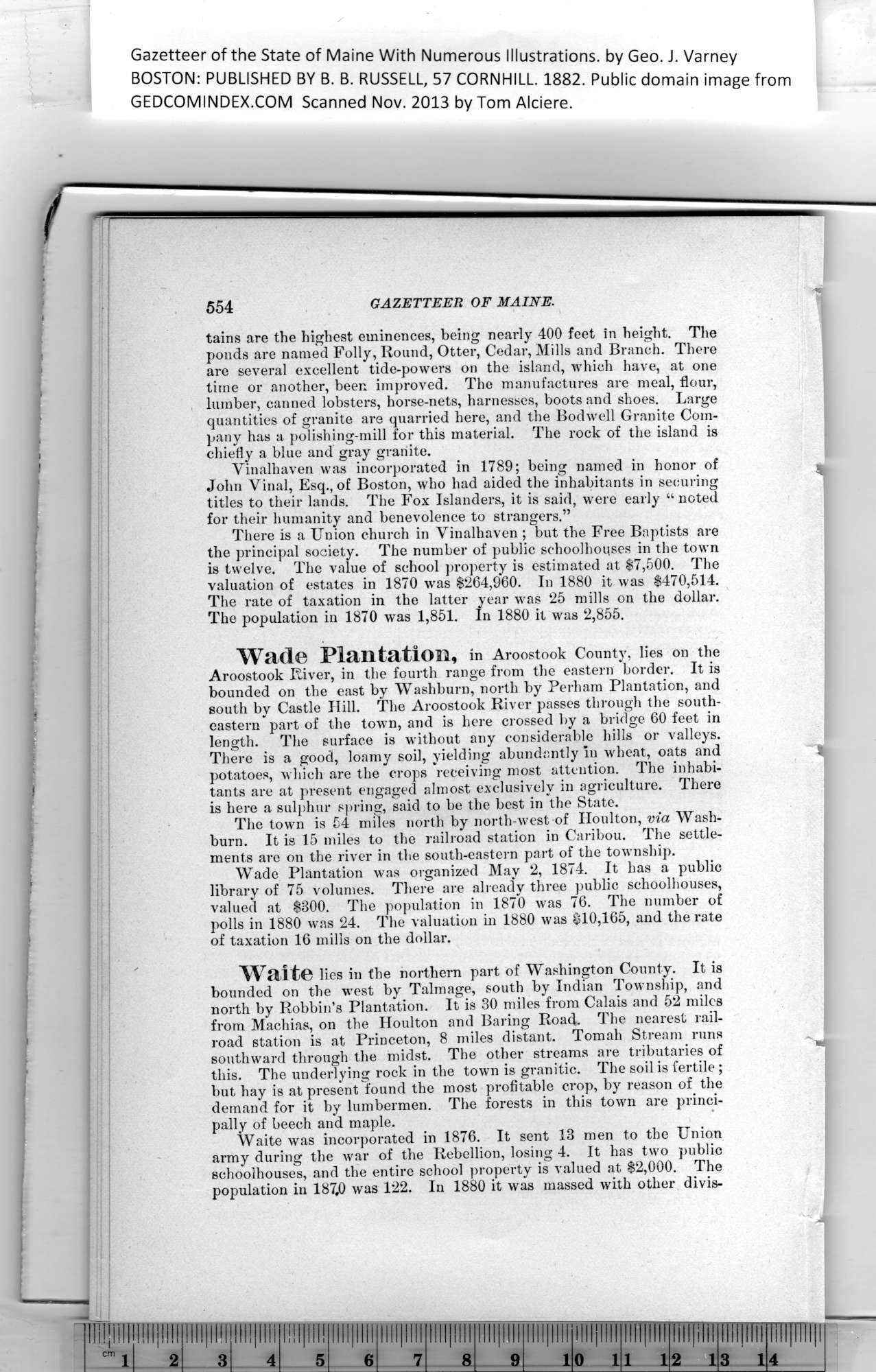|
Gazetteer of the State of Maine With Numerous Illustrations, by Geo. J. Varney
BOSTON. PUBLISHED BY B. B. RUSSELL, 57 CORNHILL. 1882. Public domain image from
554 GAZETTEER OF MAINE.
tains are the highest eminences, being nearly 400 feet in height. The
ponds are named Folly, Round, Otter, Cedar, Mills and Branch. There
are several excellent tide-powers on the island, which have, at one
time or another, been improved. The manufactures are meal, flour,
lumber, canned lobsters, horse-nets, harnesses, boots and shoes. Large
quantities of granite are quarried here, and the Bodwell Granite Com-
pany has a polishing-mill for this material. The rock of the island is
chiefly a blue and gray granite.
Vinalhaven was incorporated in 1789; being named in honor of
John Vinal, Esq., of Boston, who had aided the inhabitants in securing
titles to their lands. The Fox Islanders, it is said, were early “noted
for their humanity and benevolence to strangers.”
There is a Union church in Vinalhaven ; but the Free Baptists are
the principal society. The number of public schoolhouses in the town
is twelve. The value of school property is estimated at $7,500. The
valuation of estates in 1870 was $264,960. In 1880 it was $470,514.
The rate of taxation in the latter year was 25 mills on the dollar.
The population in 1870 was 1,851. In 1880 it was 2,855.
Wade Plantation, in Aroostook County, lies on the
Aroostook River, in the fourth range from the eastern border. It is
bounded on the east by Washburn, north by Perham Plantation, and
south by Castle Ilill. The Aroostook River passes through the south-
eastern part of the town, and is here crossed by a bridge 60 feet in
length. The surface is without any considerable hills or valleys.
There is a good, loamy soil, yielding abundantly in wheat, oats and
potatoes, which are the crops receiving most attention. The inhabi-
tants are at present engaged almost exclusively in agriculture. There
is here a sulphur spring, said to be the best in the State.
The town is 54 miles north hy north-west of Houlton, via Wash-
burn. It is 15 miles to the railroad station in Caribou. The settle-
ments are on the river in the south-eastern part of the township.
Wade Plantation was organized May 2, 1874. It has a public
library of 75 volumes. There are already three public schoolhouses,
valued at $300. The population in 1870 was 76. The number of
polls in 1880 was 24. The valuation in 1880 was $10,165, and the rate
of taxation 16 mills on the dollar.
Waite lies in the northern part of Washington County. It is
bounded on the west by Talmage, south by Indian Township, and
north by Robbin’s Plantation. It is 30 miles from Calais and 52 miles
from Machias, on the Houlton and Baring Road. The nearest rail-
road station is at Princeton, 8 miles distant. Tomah Stream _ runs
southward through the midst. The other streams are tributaries of
this. The underlying rock in tbe town is granitic. The soil is fertile;
but hay is at present found the most profitable crop, by reason of the
demand for it by lumbermen. The forests in this town are princi-
pally of beech and maple.
Waite was incorporated in 1876. It sent 13 men to the Union
army during the war of the Rebellion, losing 4. It has two public
schoolhouses, and the entire school property is valued at $2,000. The
population in 187.0 was 122. Ia 1880 it was massed with other divis-
PREVIOUS PAGE ... NEXT PAGE
This page was written in HTML using a program written in Python 3.2
|
